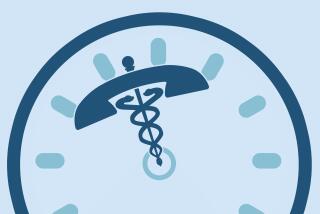What Should Not Be in IRA, 401(k)
- Share via
It’s hard to say what to put in a retirement account. The answer depends on risk tolerance, time until retirement and the rest of someone’s assets.
It’s much easier to say what should not be in a retirement account, or at least what to minimize.
Clearly, tax-deferred savings--whether in a 401(k) plan or through individual retirement accounts (IRAs)--are a cornerstone of any financial plan. But most people need to have some funds outside those plans anyway, and it pays to know what kinds of investments make sense in each place.
Here are four investments that might be fine for your taxable accounts but that should be reconsidered if you own them within a 401(k) or IRA:
* Tax-free bond funds.
While this should be obvious--indeed, tax-frees aren’t usually a 401(k) option--it’s still a common mistake.
The big plus for tax-advantaged retirement accounts is that your money grows without taxes slowing it down.
But a tax-free bond or fund pays a lower yield in exchange for tax-exempt status. Why give up a yield for something you don’t need?
Worse yet, you pay taxes on income when you withdraw it from a retirement account, which means that your low tax-free income actually becomes taxable. That’s ugly.
“You wouldn’t carry two umbrellas in the rain,” says Rochelle Lamm Wallach, president of Milwaukee-based Strong Advisory Services.
Note that some tax-frees are worse than others. Municipal bonds are generally the ones to keep out of tax-exempt accounts. Less of a worry are U.S. Treasury bonds, which are exempt from state taxes but not federal taxes. Since state taxes are comparatively low or, in some states, nonexistent, that’s less of a factor.
“Tax-free bond funds may belong as one of your investments, but outside of an IRA,” Wallach says.
* Company stock funds.
The biggest chunk of money in 401(k) plans is held in the employer’s stock--23% of all assets--according to Access Research Inc., which tracks the retirement plan business.
That’s a bit more of the pie than is invested in either guaranteed or stable-value accounts or diversified equity funds.
Company stock can be a great stock, and employees have no choice when that is the only way their employer matches 401(k) contributions.
But in terms of volatility, the company stock fund is an eggs-in-one-basket approach to investing. The effect is greater because your employer’s fortunes determine both your current income--salary--and future income.
If the company has a setback, it could jeopardize both your job and your future.
“You may get great performance in the company stock, but you also have the most volatility and risk there,” says David L. Wray, president of the Chicago-based Profit Sharing/401(k) Council of America.
“If you invest heavily there, you must be especially vigilant and ready to change--and you have to make sure your feelings for the company don’t cloud your decisions,” Wray says.
Typically, financial advisors suggest holding no more than 15% of an investment portfolio--both in retirement and taxable accounts--in individual stocks or sector funds.
Make sure your company stock holdings stay within that limit.
* High-turnover, risky individual investing.
If you plan to play the stock market a bit with some money you are willing to risk losing in hopes of riding the next Netscape or a new fad, you might as well do that outside your IRA. (401(k)’s don’t allow such shenanigans anyway.)
That way, if you bet wrong and lose some money, at least you’ll be able to deduct it against other gains or regular income. If you sell at a profit, at least that’s taxed at the more modest capital gains rate.
In an IRA, your losses from speculation are just that--losses.
* Low-turnover, low-yield growth funds.
A fund with a buy-and-hold strategy--that earns its money letting stocks appreciate--is better-suited for taxable accounts.
Unlike high-turnover or market-timing funds--where trading creates capital gains that are passed on and taxed each year--a low-turnover, low-dividend fund defers taxes by its very nature.
As a result, the bulk of the capital gains aren’t realized until you sell the fund, at which point the tax bill tops out at 28%.
Retirement account withdrawals, however, are taxed as income. The current tax rate goes as high as 39.6%--which certainly could strip the fund of some of its tax efficiency.
And who knows what the future tax rate will be when you withdraw funds? It might be even higher.
Charles A. Jaffe is a columnist at the Boston Globe. He can be reached by e-mail at jaffe@globe.com or at the Boston Globe, Box 2378, Boston, MA 02107-2378.
More to Read
Inside the business of entertainment
The Wide Shot brings you news, analysis and insights on everything from streaming wars to production — and what it all means for the future.
You may occasionally receive promotional content from the Los Angeles Times.










